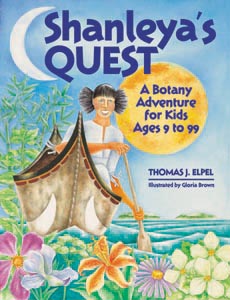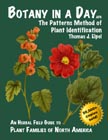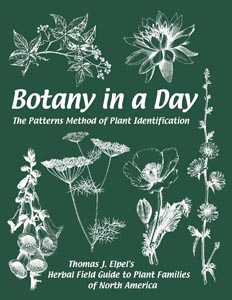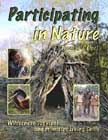Reviews from the Press
Botany in a Day (APG)
The Patterns Method of Plant Identification
Paperback, 235 pages. 6th edition, HOPS Press; 2013
Review from HerbalGram, Issue 103, August - October 2014.

As a professional plant taxonomist often saddled with teaching duties, I have used texts such as Zach Murrell's Vascular Plant Taxonomy (Kendall Hunt Publishing Company, 2010) to introduce my students to the diversity of plant families. For research purposes and when I require a broader spectrum of plant families - such as when I constructed a LUCID online key to imported botanicals for the florist industry - I often turn to books like Vernon Heywood et al's Flowering Plant Families of the World (Firefly Books, 2007). However, I have long lamented that there is no introduction for the general public, particularly for the forager and medical herbalist. A prime example of the consequences of inadequate knowledge of plant families is that of Christopher McCandless - who was played by Emile Hirsch in the 2007 Sean Penn film Into the Wild, based on Jon Krakauer's 1996 book of the same title. McCandless forages to survive in the wilderness of Alaska and ultimately poisons himself as a result of misidentification. One takeaway message from this film is that you shouldn't eat any plant unless you know what it is, and for that you need to know plant families. But how can an amateur learn this easily? A few years ago, I accidentally came across a previous edition of Botany in a Day and was delighted.
 Thomas Elpel has written Botany in a Day to cover the vascular plant families, from ferns to flowering plants, most likely to be encountered across the northern latitudes of North America. However, as he explains, the basic approach he presents is also applicable worldwide and is not limited to what he terms "the frost belt."
Thomas Elpel has written Botany in a Day to cover the vascular plant families, from ferns to flowering plants, most likely to be encountered across the northern latitudes of North America. However, as he explains, the basic approach he presents is also applicable worldwide and is not limited to what he terms "the frost belt."
The amateur immediately jumps in to try to match the living plant with keys, often "forcing" an identification that does not actually exist (the Into the Wild example immediately comes to mind). Instead, Elpel uses the same basic approach that I teach my students, which is to familiarize oneself first with the characteristics of the basic plant families (he mentions eight: the mint, mustard, parsley, pea, lily, grass, rose, and aster families). With a familiarity with basic plant families, one can then start identifying genera and species and learn more families.
 Elpel provides basic introductions to plant naming, evolution, and how plants fit into the scheme of life. He then provides fundamental information on plant anatomy and morphology so that the reader can utilize the basic keys to families. This is followed by the main content of Botany in a Day: brief discussions of the major plant families. If this approach is too difficult, Elpel also has written Shanleya's Quest: A Botany Adventure for Kids Ages 9 to 99 (HOPS Press, 2005). He maintains that with this children's book, he can introduce all eight plant family patterns to adults and kids in about two minutes. He also introduces card games, including Memory, Slap Flower, Crazy Flowers, Wildflower Rummy, and Shanleya's Harvest, a game based on the story. The next time I teach Systematic Botany for my college students, this is one trick that I will have to try to motivate my students, who increasingly come from an urbanized world and could care less about plants (sad but true).
Elpel provides basic introductions to plant naming, evolution, and how plants fit into the scheme of life. He then provides fundamental information on plant anatomy and morphology so that the reader can utilize the basic keys to families. This is followed by the main content of Botany in a Day: brief discussions of the major plant families. If this approach is too difficult, Elpel also has written Shanleya's Quest: A Botany Adventure for Kids Ages 9 to 99 (HOPS Press, 2005). He maintains that with this children's book, he can introduce all eight plant family patterns to adults and kids in about two minutes. He also introduces card games, including Memory, Slap Flower, Crazy Flowers, Wildflower Rummy, and Shanleya's Harvest, a game based on the story. The next time I teach Systematic Botany for my college students, this is one trick that I will have to try to motivate my students, who increasingly come from an urbanized world and could care less about plants (sad but true).
Botany in a Day, 6th edition, is well and amply illustrated with both black-and-white and color drawings. In addition to the standard botanical descriptions for each family, he discusses medicinal and culinary characteristics, a welcomed addition that is lacking in standard botanical introductions. He also provides a sizeable bibliography and highlights books on foraging.
 The errors are, thankfully, few and far between. For example, he writes of the mint family: "Medicinally, this family is rich in volatile oils, especially menthol." Actually, only two plants in the entire world have an appreciable content of menthol: peppermint (Mentha x piperita, Lamiaceae) and Japanese peppermint (M. canadensis). Apparently he has confused menthol, an alcohol, with the more common ketones, menthone and piperitone, which have similar odors but are not as cooling, and which are more generally distributed in the Lamiaceae. On the other hand, I was pleasantly surprised to find that Elpel is amazingly current in many areas of plant science, such as studies of symbiotic relationships, and he evinces a background in paleobotany (something that is unfortunately absent from the education of many botanists today; see "Life Begins" on pages 6-7).
The errors are, thankfully, few and far between. For example, he writes of the mint family: "Medicinally, this family is rich in volatile oils, especially menthol." Actually, only two plants in the entire world have an appreciable content of menthol: peppermint (Mentha x piperita, Lamiaceae) and Japanese peppermint (M. canadensis). Apparently he has confused menthol, an alcohol, with the more common ketones, menthone and piperitone, which have similar odors but are not as cooling, and which are more generally distributed in the Lamiaceae. On the other hand, I was pleasantly surprised to find that Elpel is amazingly current in many areas of plant science, such as studies of symbiotic relationships, and he evinces a background in paleobotany (something that is unfortunately absent from the education of many botanists today; see "Life Begins" on pages 6-7).
In short, I recommend Elpel's publications to any burgeoning botanist, horticulturist, forager, medical herbalist, or those simply interested in learning how to identify plants. In addition to the publications listed above, Elpel has authored or co-authored Foraging the Mountain West (HOPS Press, 2014) and Participating in Nature: Wilderness Survival and Primitive Living Skills (HOPS Press, 2009), or, as he puts it, "Get in touch with your wild side!" Today, survival in the wild or in a post-apocalyptic world is strangely popular, so I thoroughly recommend getting to know plants first - Elpel's books are a perfect fit.
--Arthur O. Tucker, PhD
Emeritus Professor Agriculture & Natural Resources
Delaware State University, Dover, Delaware
Botany in a Day (APG)
The Patterns Method of Plant Identification
An Herbal Field Guide to Plant Families of North America
Paperback, 235 pages. 6th edition, HOPS Press; 2013

Botany in a Day is a widely known and respected plant identification guide by Thomas J. Elpel of Pony, Montana. First published in 1996, Elpel recently released a sixth edition of the classic text. Each edition has been exceptionally engaging and useful, but with the addition of color illustrations, the adjective "lovely" has become one of the book's distinct characteristics as well.
According to Elpel, he invested "more than a thousand hours of additional work" in the new edition, both by adding the color artwork and by updating his text to APG III, the most recent system of plant classification. On the book's page in his extensive website, www.hopspress.com, Elpel writes that, "APG is a system of classification published by the Angiosperm Phylogeny Group, replacing the Cronquist system that was popular in the last few decades of the twentieth century." There Elpel also gives examples and detailed explanations of the impact of these classification changes in the book.
 While not a botanist, Elpel is an important contributor to public understanding of plants as the writer of several respected plant-focused publications aimed at the layman. As a child, Elpel spent much of his time near Virginia City with his grandmother, who was knowledgeable about plants and their uses, the outdoors, and self-sufficiency. Citing her influence, Elpel said that plants and plant identification became his passion, and he spent much of his youth studying and practicing these skills outdoors. Knowing plants was one of a range of skills that were foundational to his broader interests in outdoor survival, sustainability and self-sufficiency. As he grew into adulthood, he thoughtfully constructed a life in which he could engage in these activities by sharing them with others.
While not a botanist, Elpel is an important contributor to public understanding of plants as the writer of several respected plant-focused publications aimed at the layman. As a child, Elpel spent much of his time near Virginia City with his grandmother, who was knowledgeable about plants and their uses, the outdoors, and self-sufficiency. Citing her influence, Elpel said that plants and plant identification became his passion, and he spent much of his youth studying and practicing these skills outdoors. Knowing plants was one of a range of skills that were foundational to his broader interests in outdoor survival, sustainability and self-sufficiency. As he grew into adulthood, he thoughtfully constructed a life in which he could engage in these activities by sharing them with others.
Elpel's latest book, Foraging in the Mountain West, Gourmet Editble Plants, Mushrooms and Meats, was just published this spring, and promises to be an interesting and useful addition to his body of work.
As an author and educator, Elpel focuses on wilderness skills, botany and ecology, sustainable building and green economics. He does this through his writing, which reaches the public through his publishing business, HOPS Press, LLC, and through his teaching. Elpel offers courses through his Green University® LLC (for adult learners) and through his OWLS (Outdoor Wilderness Living School) for youth.
 Elpel's writing also makes notable forays into philosophical explorations of the nature of reality, lifestyle choices and humankind's relationship with the natural world. Elpel's Participating in Nature is an excellent example of a book that blends each element of his work and interests together into an extremely thoughtful and compelling text.
Elpel's writing also makes notable forays into philosophical explorations of the nature of reality, lifestyle choices and humankind's relationship with the natural world. Elpel's Participating in Nature is an excellent example of a book that blends each element of his work and interests together into an extremely thoughtful and compelling text.
Elpel also regularly writes articles and gives presentations around the country, and has produced seven educational videos. He cites the early death of his father, when Elpel was only 12, as a primary influence on the intensity with which he approaches his work, saying that it drove him to an, "awareness of how short and precious life is," and that, "whatever we're going to do, we need to do it now instead of later."
When asked about his focus on sharing his knowledge and educating others, Elpel said, "Making a difference is what I'm all about." He went on to say, "To me, the one thing that matters is what we can leave behind for the next generation. I feel very fortunate to be in this world with all of its' wonderful gifts, so the one thing I can do is share what I've learned."
-- Kristen Prinzing, Zone 4 Magazine. Bozeman, Montana. Summer 2014.
Botany in a Day
The Patterns Method of Plant Identification
An Herbal Field Guide to Plant Families of North America
Paperback, 221 pages. 5th edition, HOPS Press; 2004.

Yes you can learn a lot in a day. Thomas Elpel, outdoorsman and nature teacher extraordinaire, has self-published a book that puts an easy spin on a complicated subject. I guess you could call Botany in a Day: The Patterns Method of Plant Identification the Rosetta Stone way of identifying plants. Once you get past the book's short tutorial that teaches the basics, you'll learn there are only seven key patterns that identify more than 45,000 plants worldwide. So, instead of trying to identify individual plants, you start with an overall view of their families. If you hike, backpack or just like to know what you're looking at when your taking a walk, this herbal primer makes it easier and more fun to "name that plant!" Master the seven families and then use the book as a reference guide. Elpel has several YouTube tutorials to go with the book. Google him, too. If botany doesn't appeal to you, he has tutorials to build a masonry fireplace. Quite the Renaissance man..
-- South Sound Magazine. Tacoma, Washington. February-March 2013.
Botany in a Day
Thomas J. Elpel's Herbal Field Guide to Plant Families
Paperback, 196 pages. 4th edition, HOPS Press; 2000.

Botany in a Day: Thomas J. Elpel's Herbal Field Guide to Plant Families presents a simplified way of identifying plants through learning the patterns in over 100 plant families. The author states that up until now a serious study of plants was impractical for most people because of "the immensity of the field". This becomes apparent as he lists "the hierarchy of the Plant Kingdom," which includes division, class, subclass, order, family, subfamily, tribe, genus and species. Elpel notes that it is on the family level that enough similarities are found between plants to aid identification and perhaps to guess at the plant's uses. He includes a chapter on plant properties which contains cautions but is also a distillation of his own experience and philosophy, his connection with the "Whole," his belief that each of us has an "inner knowing." The book is interesting, well-written and illustrated with line drawings. It also contains a bibliography, indices of plants by genus and plants and plant families by common names, as well as an index of plant families by Latin name.
-- Ecology Action Newsletter. Willits, California. February 2003.
Go to Botany in a Day





 HOPS Press LLC
HOPS Press LLC












